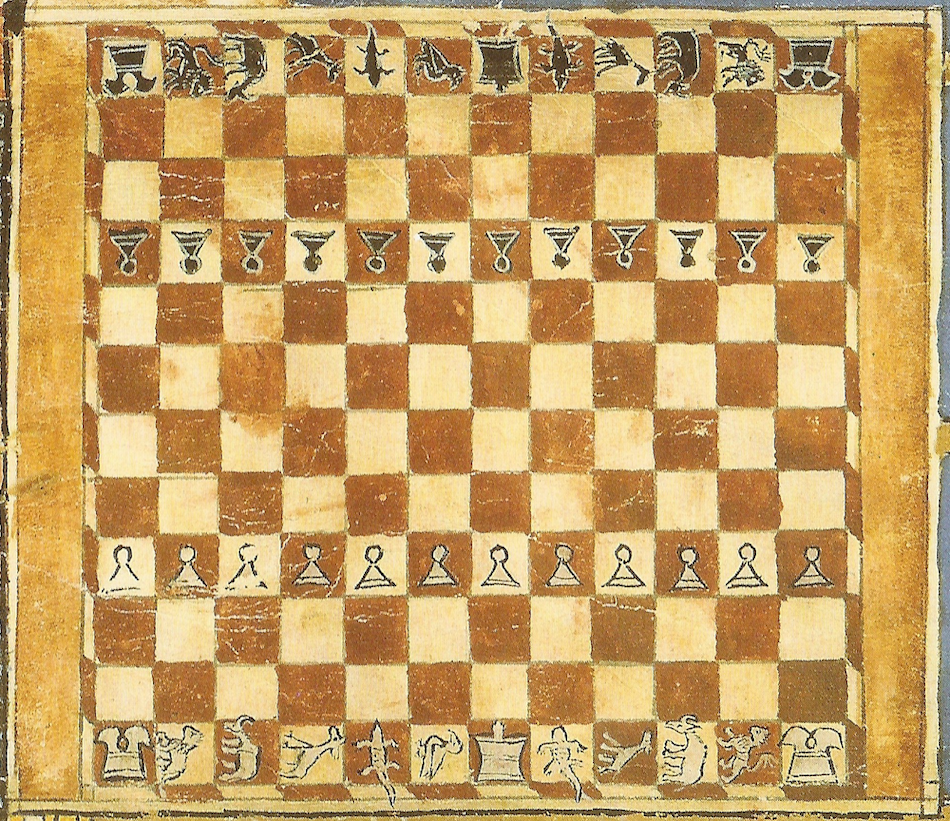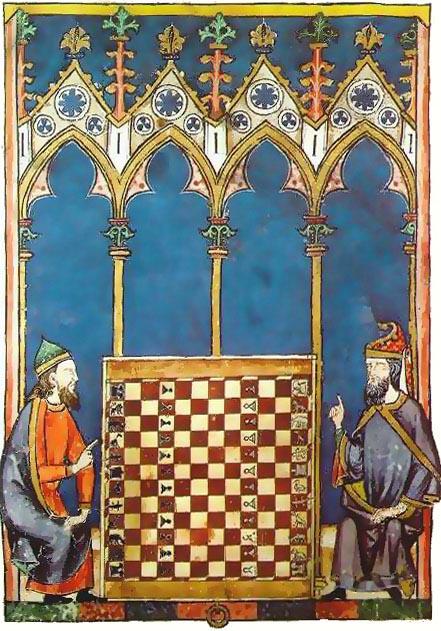Grant Acedrex
This large chess variant played on a 12x12 spaces board is found in a medieval Spanish codex (a form of ancient book) known as "Juegos diuersos de Acedrex, dados, y tablas con sus explicaciones, ordonados por mandado del rey don Alfonso el Sabio"(Various games of Chess, Dice and Tables with their explanations, ordered by request of King Alfonso the Wise). This king was Alfonso X (1221-1284), King of Castile, the central kingdom of Spain in Middle Ages. Author and poet, he compiled many books. This one was completed in 1283 in Seville, and is conserved at El Escorial near Madrid. It represents the most important extant testimony about games in the Middle Ages. Within 98 pages, it describes, details and comments on many rules and problems for several games.
This game has been (very briefly) described by H.J.R. Murray in his monumental "History of Chess" (1913, page 348). Then, his description has been re-used by other subsequent authors like John Gollon (1968), D.B. Pritchard (1994) or David Parlett (1999). The description available on this Chess Variants page was made accordingly with that information. However, as often with Murray, who had a moderate interest in chess variants, there are some inacuracies or misinterpretations.
The complete text of the Alfonso's codex written in medieval Spanish has been studied by Sonja Musser and this author in the context of Sonja Musser's PhD. The original medieval Spanish text as well as the English translation made by Sonja Musser and I are available on this web site. With this original source, it appears that Murray's description had a few incorrect statements, and that it would be worthwhile to make an updated description of the game.
The original name of this game as written on the codex is Grant Acedrex. Murray used a different spelling for the the adjective and wrote Grande Acedrex. It appears that the orthography was not as well stabilized as it has become in our modern era. The forms "grand", "grande" and "grant" are all three of them encountered in the overall text of the codex but only "grant" is found in association with "acedrex". Grant Acedex is therefore the correct form. It can be translated as Gran Ajedrez in modern Spanish and Large Chess or Grand Chess in English.
The codex shows an illustration with two players separated by a board. The detail of the board with the pieces on the initial setup is presented here:

Setup
Pieces
For every piece the original name in medieval Spanish (MS) is given.
King (MS: Rey): steps 1 square in any direction. On his first move, it has a privilege detailed below.
Pawn (MS: Peon): moves as in medieval regular chess at this epoch. That means that the initial non-capturing double step is allowed for all Pawns. However, the double-step is no longer possible after a first capture is made (it is understood that a capture by a Pawn of either player is meant, but the original text is ambiguous here). There is no en-passant capture.
Rook (MS: Roque): identical to the modern chess Rook, except there is no castling.
Anqa (MS: Aanca): moves 1 diagonal step followed by any number away on lines or columns. It may not jump over occupied squares. The Anqa is a mythical beast from the Arabian mythology which underlines the link between this game and the medieval Muslim chess variants. It was seen as a giant bird able to prey on elephants, and it was represented on the codex illustration as a sort of eagle. Murray translated it as gryphon, which was a different monster (half eagle - half lion), and this name has now been popularized by modern chess variant players. The faulty modern use of Aanca for designating a different move than the one of the Gryphon, which is sometimes used in the Chess Variant Pages, is wrong and should be avoided.
Cockatrice (MS: Cocatriz): moves exactly as the modern chess Bishop. It must be noted that at the time of the codex, the 13th century, medieval chess had no modern Bishop but an "Alffil" instead which was moving as the Alfil of modern chess variants. The Cockatrice was a two-legged serpent-like monster with a rooster's head in medieval sources, though this piece is represented as a sort of crocodile in the codex illustration. Murray translated it as crocodile.
Giraffe (MS: Zaraffa): it is the (3,2) leaper, meaning that it may go to the opposite square of a 4x3 rectangle, leaping over occupied squares if any. This move is also made by stepping 1 square orthogonally followed by 2 squares diagonally. This move is different from the move understood by Murray and consequently, modern chess variant players call Giraffe a different piece, the (4,1) leaper, and call this historical Spanish piece a Zebra. Zaraffa and Zebra both start with a Z, a convenient mnemonic.
Unicorn (MS: Unicornio): it leaps like a Knight, then proceeds diagonally away from the square it leaped to any number of vacant squares. This piece is depicted as a rhinoceros in the codex illustration, which is an indication of how exotic animals were poorly known in Europe during the Middle Ages and confused with mythical animals. Murray did not interpret the move of the piece correctly.
Lion (MS: Leon): it leaps 3 squares orthogonally or 2 squares orthogonally followed by 1 diagonal step. It may leap over occupied squares. Therefore it combines the moves of the Camel and the Threeleaper of modern chess variant nomenclature. Murray did not interpret the move of the piece correctly.
Rules
King's privilege: for its first move, the King can go 2 squares in any direction, leaping over the intermediate square if it is occupied (the text says as does the Alfferza. The Alfferza was the Fers, the Queen in medieval chess). That means it may leap to the 2nd square in straight line: straight ahead, diagonally or sideways, but not like a chess Knight. It may pass over an occupied square. The King cannot capture when jumping. The text does not specify if it may jump to escape a check or pass over a square controlled by the opponent. It is supposed that this was forbidden.
Pawn's promotion: when a Pawn reaches the opposite side of the board, it is replaced by the piece corresponding to the file on which it lands. On the g-file (the King's file), the Pawn is promoted to an Anqa.
End of game: nothing is said about this for this particular game in the codex. The rules for the end of the game were probably similar to those of the standard medieval chess which are given in the same codex (this is what is called the "Spanish assize"). Victory is obtained by checkmate. According to Murray who has deeply studied the classical chess problems in the codex, baring the opponent's King was a victory. Nothing is said about stalemate, however stalemate was considered half a win in Spain at the end of the 15th c. (so, about 200 years later) according to Lucena's. No more can be said.
Notes
A Game Courier preset enforcing the rules and following those presented here has been proposed by Daniel Zacharias.
In this preset, bare king and stalemate are wins. Here's the link: Grant Acedrex.

 This 'user submitted' page is a collaboration between the posting user and the Chess Variant Pages. Registered contributors to the Chess Variant Pages have the ability to post their own works, subject to review and editing by the Chess Variant Pages Editorial Staff.
This 'user submitted' page is a collaboration between the posting user and the Chess Variant Pages. Registered contributors to the Chess Variant Pages have the ability to post their own works, subject to review and editing by the Chess Variant Pages Editorial Staff.
Author: Jean-Louis Cazaux.
Last revised by Jean-Louis Cazaux.
Web page created: 2023-12-02. Web page last updated: 2023-12-04